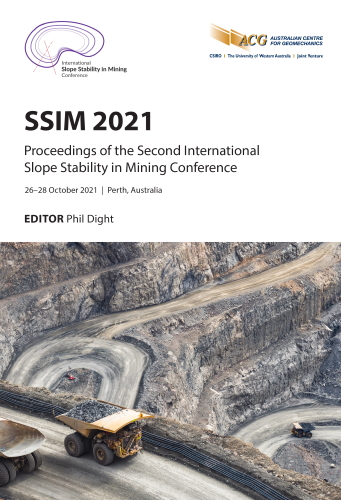Horizontal drain holes: a case study

|
Authors: Duran, A |
DOI https://doi.org/10.36487/ACG_repo/2135_26
Cite As:
Duran, A 2021, 'Horizontal drain holes: a case study', in PM Dight (ed.), SSIM 2021: Second International Slope Stability in Mining, Australian Centre for Geomechanics, Perth, pp. 415-428, https://doi.org/10.36487/ACG_repo/2135_26
Abstract:
Horizontal depressurisation holes (drain holes) form one of many options that are available for the depressurisation of mine pit slopes to improve stability. Whilst horizontal drain holes have been employed for over 80 years (Royster 1980), the literature commonly indicates their benefit to slope stability through the causal relationship of slope movements decreasing after drain holes have been installed (Seegmiller 1979; Rahardjo et al. 2003; Tsao et al. 2005; Beale et al. 2013). Clermont Coal mine is located in an atypical coal mine setting where a major thrust fault in the west wall results in Cambrian aged foliated metamorphics (basement) being thrust over Permian aged coal measures. Geotechnical studies have identified an area of the west wall where a significant exposure of foliated metamorphics will be exposed over most of a 200 m high slope with foliation dipping towards the east. Stability analyses have inferred the potential for unfavourable stability at the overall pit wall scale. Owing to existing infrastructure at the crest, a cutback or unloading were not considered as viable design alternatives whilst leaving a buttress of coal at the toe was considered economically less desirable. As such, a depressurisation program was considered, with horizontal drain holes put forward to depressurise the slope and improve stability. This paper presents an overview of the results of the depressurisation program and with particular emphasis on the interpretation of pore pressures within the slope based on the combination of both vertical and horizontal multi-nested vibrating wire piezometers.
Keywords: depressurisation, drain holes, horizontal piezometers, slope stability, open pit, coal mining
References:
Australasian Groundwater and Environmental Consultants Pty Ltd 2018, Clermont Coal Mine Packer Testing, report G1888.
Beale, G, De Sousa, J, Smith, R & St Louis, B, 2013, ‘Implementation of Slope Depressurisation Systems’, in G Beale & J Read (eds), Guidelines for Evaluating Water in Pit Slope Stability, CSIRO Publishing, Collingwood.
Brawner, CO, Pentz, DL & Sharp, JC 1971, ‘Stability Studies of a Footwall Slope in Layered Coal Deposit’, Proceedings of the 13th US Symposium on Rock Mechanics, American Rock Mechanics Association, Alexandria, pp. 329–365.
Rahardjo, H, Hritzuk, KJ, Leong, EC & Rezaur, RB 2003, ‘Effectiveness of horizontal drains for slope stability’, Engineering Geology, vol. 69, pp. 295–308.
Royster, DL 1980, ‘Horizontal drains and horizontal drilling: an overview’, Transportation Research Record, vol. 783, pp. 16–20.
Seegmiller, BL 1979, Horizontal drains - their use in open pit mine dewatering, Drainage Control for Surface Mines, Miller Freeman Publications, Inc., San Francisco.
Smith, RDC & Miller, DE 1995, ‘The Blair Athol Coal Mine’, Proceedings of the Bowen Basin Symposium 1995: 150 Years On, Geological Society of Australia, Coal Geology Group 1v, Mackay, pp. 265–270.
Silwa, R 2019, Clermont thrust Fault Interpretation, January 2019 Update, Integrated Geoscience Pty Ltd report to Clermont Open Cut.
Tsao, TM, Wang, MK, Chen, MC, Takeuchi, Y, Matsuura, S & Ochiai, H 2005, ‘A case study of the pore water pressure fluctuation on the slip surface using horizontal borehole works on drainage well’, Engineering Geology, vol. 78, pp. 105–118.
Wu, G & Chieng, ST 1991, ‘A Convenient Drain Spacing Formula for Layered Soils’, Canadian Agricultural Engineering, vol. 33,
pp. 239–243.
© Copyright 2026, Australian Centre for Geomechanics (ACG), The University of Western Australia. All rights reserved.
View copyright/legal information
Please direct any queries or error reports to repository-acg@uwa.edu.au
View copyright/legal information
Please direct any queries or error reports to repository-acg@uwa.edu.au